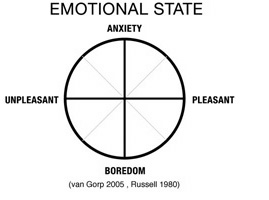 Another way to describe the relationship between emotions is in terms of the relationship between two dimensions; value and arousal…
Another way to describe the relationship between emotions is in terms of the relationship between two dimensions; value and arousal…
Value and Arousal
Everything we experience is either good, bad, or somewhere in between. This is called “value” or “valence”)
And our experiences always occur somewhere in between being asleep or really excited. To some extent, our pre-existing physical states determine how intensely we feel good or bad. Emotion researchers call it the level of “arousal†in the body, and define it as the range between anxiety and boredom (or arousal vs. sleepiness – it’s a measure of our physical state).

Arousal commands attention, and is closely related to other concepts such as anxiety, attention, agitation, stress, and motivation. The arousal level can be thought of as the capacity you have available to work with. Too little arousal may make a user inert. Too much has a focusing affect, and can lead to ‘tunnel vision’.
Highly agitated individuals may be great at taking action, but poor at thinking creatively and problem solving. (Norman 2004) Different applications require different optimal levels of arousal. Entertainment-oriented media should be more highly arousing (i.e stimulating) than task-oriented media, for example.
Emotional Expressions and Representations
We can also tell emotions apart based on how they are expressed. Public expressions of emotion communicate our feelings to others. This includes changes in how we appear (our facial expressions and breathing), what we say (our conversation or interaction), and how we behave. If the same public expressions of emotion occur again and again over time, what was once seen as an ’emotion’ will be seen as a personality trait.
So, emotions and feelings changes how we appear, how we converse with others and how we behave. Emotions are different from feelings. Feelings are our perceptions of the particular state of different parts of the body. Particular body states are associated by the mind with certain emotions, types of mental processing, and ways of acting.
From these perceptions, the mind creates ‘body maps’ that describe the parts and state of the body at particular times. Body maps are another form of internal representation. Using these body maps allows the mind to ignore certain aspects of the body when necessary for survival. For example, it may be useful for the mind to ignore the experience of pain in the body when the most urgent need is to flee from danger. (Damasio 2003)
The fact that feelings and emotions result from the internal representations that we make of external objects means that the brain acts on the internal representation in accordance with our emotional reactions to change the meaning over time. Externally, the object may stay the same, but internally, the emotional responses and feelings we have towards it; the emotional meaning, may change.
NEXT: 5. Colour, Emotion and Attention
PREVIOUS: 3. Emotions, Moods, Sentiments and Personality Traits
2. The Influence of Emotional Affect
1. An Introduction to Emotions
Coming Soon: All About Design for Emotion